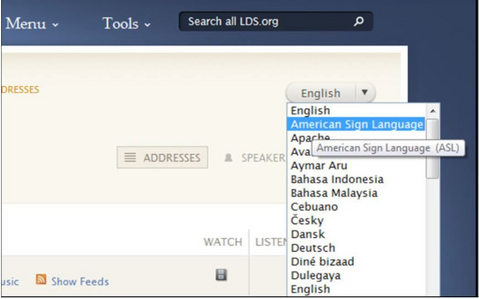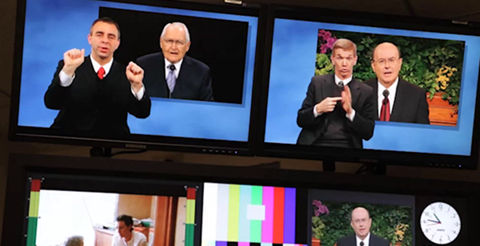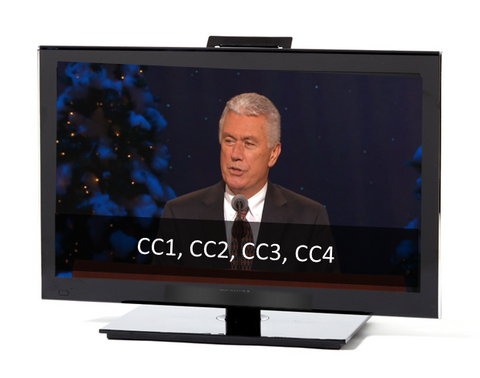Content found in this wiki may not reflect official Church information. See Terms of Use for more information.
Using Accessibility Technology
>Meetinghouse Technology > Audio Video Distribution
Technology enables us to meet the needs of minority language speakers and the hearing impaired. This article discusses how to use assisted-listening systems (ALSs), show American Sign Language (ASL) in broadcasts, add closed captions to broadcasts and videos, and use interpretation equipment.
TASK: SETTING UP ASSISTED-LISTENING SYSTEMS
Church members who use a personal hearing aid often find that it does not adequately receive the sound from the sound system. Others with minor hearing impairments sometimes have difficulty understanding speech in large rooms such as chapels. To help these individuals, many meetinghouses have a wireless ALS.
- Locate the ALSs of each building.
- Each building is equipped with two ALS devices, and more can be requested from your local facilities management group (FMG) if needed.
- Set the channel on the ALS.
- Ideally, to eliminate difficulties for stake members, the channel will be the same for all meetinghouses.
- Church ALSs operate at the 70 MHz band.
- Give the ALS to the person in need.
- Explain to the user how the device works.
- Refer to the owner’s manual for specific device operation questions.
- Earphones should be permanently given to repeat users; receivers should not.
- Those who wish to do so can purchase their own devices.
Notes:
- A special neck loop is also available that retransmits the signal to the user’s hearing aid. In order to use the neck loop, the individual’s hearing aid must have a switch for use with a telephone, and the switch must be in the “T” (telephone) position.
- The earphone jack on the receiver is also the power switch, so the earphone and neck loop should be unplugged when they are not in use. For sanitary reasons, earphones should be given to repeat users to keep. The pocket-size receivers should be checked out from the materials center.
- Many countries restrict the power radiated by Church hearing-impaired system transmitters. The transmitter or antenna should not be modified to increase the coverage.
- Generally, ALSs from different brands are still compatible with one another.
TASK: SETTING UP AMERICAN SIGN LANGUAGE

ASL is available for Church broadcasts in North American meetinghouses via the internet. Depending on your satellite connections, it may also be available via satellite. Priesthood leaders should coordinate requests for satellite ASL equipment with their facilities manager.
- Review how to broadcast via internet.
- Go to ChurchofJesusChrist.org/broadcasts and select the desired broadcast.
- From the language drop-down menu in the top right corner, choose American Sign Language.
- Remember that picture quality is important for reading hand signals.
- Use a wired connection to provide a clearer and more reliable picture.
- Remember that picture quality is important for reading hand signals.
- Decide on the best location to show the ASL broadcast.
- The broadcast may be shown in a separate room or on a separate monitor within the same room.
- For TV connection instructions, please review how to connect a TV.
TASK: SETTING UP CLOSED CAPTIONING
Closed captioning for the hearing impaired is available in many areas. If it is available in your area, at least one television should be set up during broadcasts for those who need this service. Sample closed-captioning data is broadcast at least one hour before any major broadcast in order to test the setup.
- Set up the TV monitor in the desired viewing area.
- For more information on using a TV, click here.
- For more information on how to connect a TV to a satellite broadcast, click here.
- Go to the TV’s menu screen and select the closed-captions menu.
- For more details, see the TV’s owner’s manual.
- Select the desired language.
- CC1—English
- CC3—Spanish
- CC4—Portuguese
Notes:
- Closed-caption channels selected on the TV affect only the language of the text, not the spoken language heard through the TV.
- TV HDMI inputs are not compatible with closed captioning. If your chapel has HDMI distribution, locate the composite video output (normally on the front of the modesty rail millwork).
TASK: SETTING UP INTERPRETATION EQUIPMENT
Congregations with multiple language needs should coordinate with their local FMG. The FMG will obtain the necessary equipment to provide simultaneous interpretation of meetings. Translation assistance is provided through special receivers and headphones. Interpretation systems are portable and can be used anywhere in the meetinghouse.
- Ensure that the meetinghouse has the necessary equipment to provide interpretation of meetings.
- Contact your local FMG if equipment is needed.
- Older equipment has proved very durable and is compatible with newer equipment.
- Lend interpretation devices to all who require them.
- For sanitary reasons, it is recommended that headphones not be transferred from person to person where possible.
- Ensure that the RF channel is the same on the interpreter’s and listeners’ devices.
- Ideally, the same channel will be used throughout the stake to minimize difficulties in use.
- The interpreter speaks into the microphone to live-translate the meeting.
- The microphone should be sensitive enough to accurately broadcast a quiet or whispering voice.
- The transmitter broadcasts the interpreter’s words to people wearing headphones in the congregation.
Note: To allow part of a congregation to hear a different language without having to be in a different room during satellite broadcasts, use a Williams Sound transmitter. Connect the Williams Sound transmitter line-level RCA jack input to a VCR or TV monitor (tuned to the needed language channel) that is connected to the satellite. FMGs can assist you with these connections.
- It is not normally recommended to display closed captioning on the main screen for all to view. The audio and captions are often out of sync, which can distract and frustrate those who do not need captions.
ListenWIFI for Assistive Listening and Interpretation
This technology is currently being piloted in 125 meetinghouses in North America.
- Role-Specific Instructions
- Stake Technology Specialists
- Ward Leaders (includes links to printable 1-page handouts for Church attendees to use the ListenWIFI app)
- Language Interpreters
- Using the Manufacturer (Loaner) Audio Receiver
- Narrated Overview (9 min). Gives an overview of ListenWIFI, its key features and benefits, and some responsibilities of ward leaders, temporary support personnel, interpreters, technology specialists and stake building reps.



